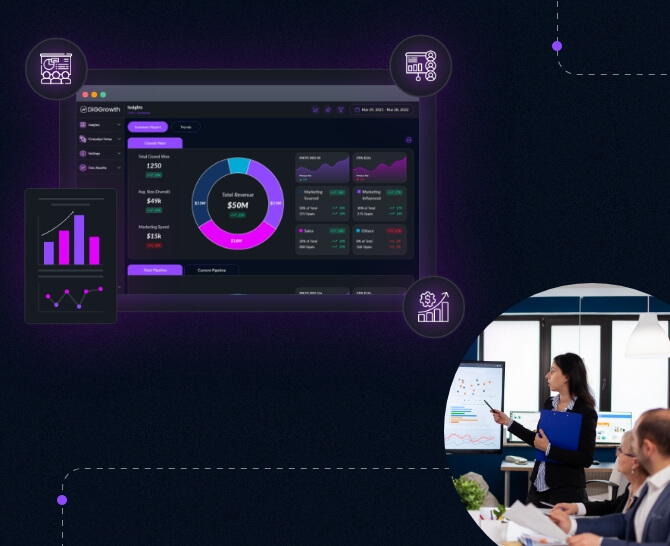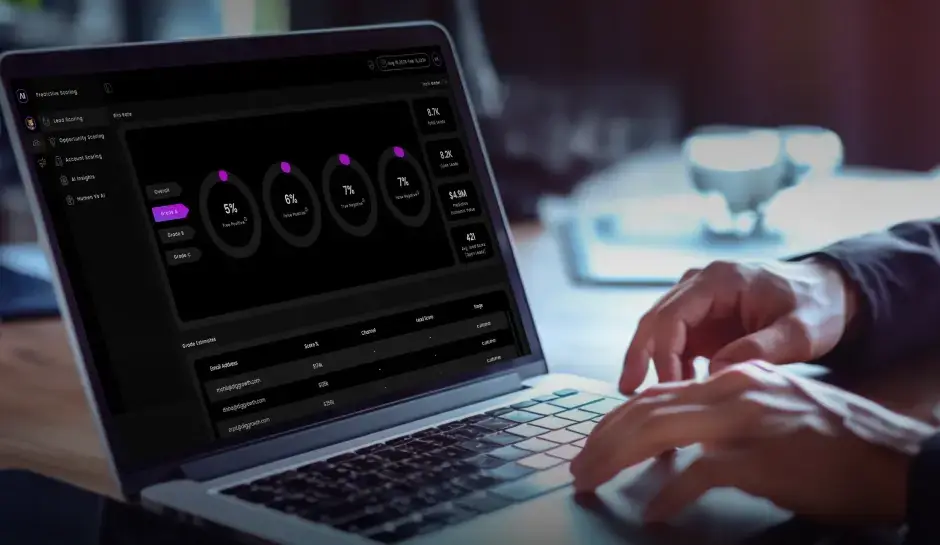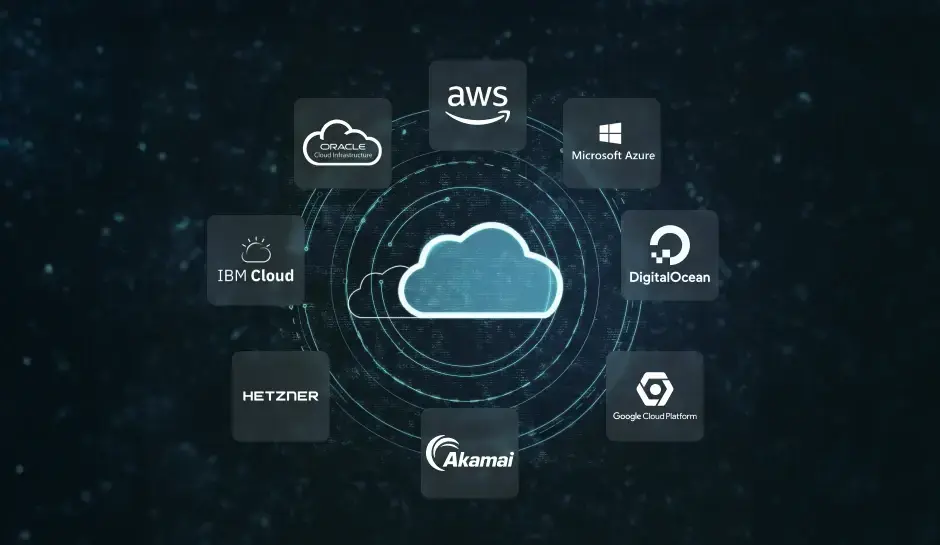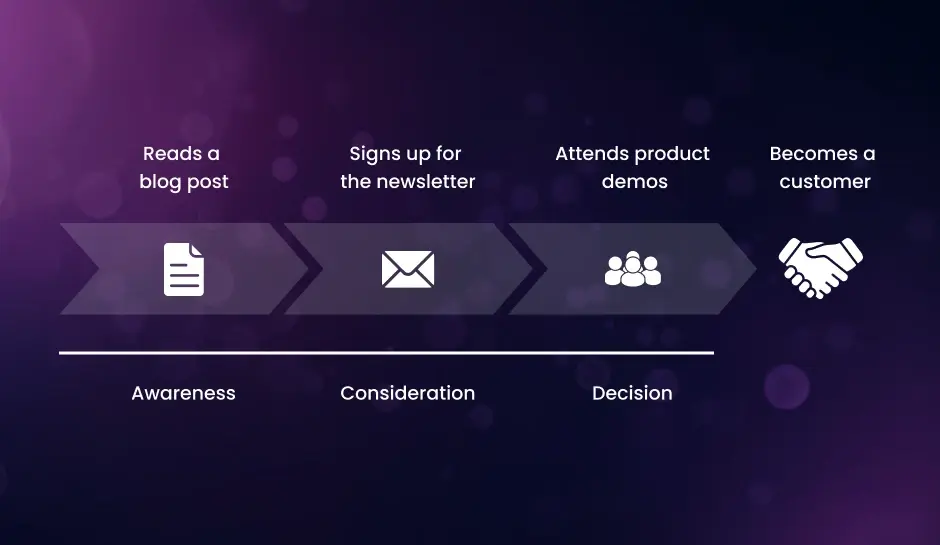
How Can Marketing Teams Thrive on a Lean Budget
A lean marketing budget can help you reach your target audience, generate leads, and increase sales, all while keeping costs under control. In this blog post, we’ve covered the ways in which marketing teams can achieve their goals on a tight budget.
For folks running a marathon, hydration is key to finishing the race. That’s why they carry a water bottle along – a limited resource that they need to use wisely in order to make it to the finish line. The same can be said for a marketing budget. CMOs often face the challenge of limited financial resources, making it difficult to achieve marketing objectives.
That’s where a lean marketing budget comes in. A lean marketing budget is a limited amount of resources that is used wisely to achieve marketing goals. Creating a lean marketing budget is important for businesses of all sizes. It requires a strategic approach that focuses on maximizing the impact of every dollar spent.
A lean marketing budget can help you reach your target audience, generate leads, and increase sales, all while keeping costs under control. In today’s competitive market, it’s important to make every dollar count, and a lean marketing budget is one way to do that. In this blog post, we will talk about the ways marketing teams can achieve their goals on a tight budget.
Define Your Goals and Target Audience
In a marathon, it’s important to know how much water you need to drink to stay hydrated and avoid cramping or dehydration. Too much water can lead to bloating and discomfort, while too little water can lead to fatigue and other complications. Similarly, in marketing, it’s important to know your goals and target audience to avoid wasting your limited resources and achieve your desired outcomes.
Defining your goals and target audience is crucial in creating a lean marketing budget. By setting specific and measurable goals, you can focus your efforts on the most important areas and avoid wasting resources on irrelevant activities. Goals should be specific, measurable, achievable, relevant, and time-bound. This helps you to track progress and adjust your strategy as needed to achieve your objectives.
You should also identify your target audience to ensure that your marketing efforts are reaching the right people. To identify your target audience, consider their demographics, interests, behaviors, and pain points. Use tools like surveys, focus groups, and customer feedback to gather this information. Once you have a clear picture of your target audience, you can tailor your marketing message to better resonate with them.
Measuring the success of your marketing efforts is also critical to optimizing your lean marketing budget. By using metrics like website traffic, conversion rates, and social media engagement, you can determine which marketing tactics are working and which ones need improvement. This allows you to allocate your limited resources more effectively and achieve better results.
Leverage Digital Marketing Channels
Businesses need to know which digital marketing channels they can trust to reach their target audience and maximize their budget. Digital marketing channels are vital in today’s world, as they offer businesses a cost-effective way to reach their audience and build brand awareness.
There are several digital marketing channels available, including search engine optimization (SEO), pay-per-click (PPC) advertising, email marketing, and social media marketing. Each channel has its own strengths and weaknesses, and it’s important to prioritize and leverage the channels that will give you the best results.
SEO is a popular digital marketing channel that involves optimizing your website and content to rank higher in search engine results pages (SERPs). This can help increase your website traffic and generate leads. PPC advertising, on the other hand, involves paying for ads to appear at the top of search results or on relevant websites. This can be a good option for businesses with a smaller budget as you only pay when someone clicks on your ad.
Social media is another effective digital marketing channel. It involves using social media platforms like Facebook, LinkedIn, Twitter, and Instagram to connect with your audience and promote your brand. This can be a cost-effective way to reach your audience and build brand awareness.
To prioritize and leverage digital marketing channels effectively, it’s important to identify which channels will be most effective for your business based on your target audience and marketing goals. For example, if you are targeting an older demographic, social media marketing may not be as effective as email marketing. It’s also important to continuously monitor and analyze your results to make adjustments to your strategy as needed.
If you do encounter a digital marketing channel that is not generating the results you expected, it’s important to re-evaluate and adjust your strategy. For example, if your PPC ads are not generating enough clicks, you may need to adjust your targeting or ad copy to better reach your audience.
Overall, leveraging digital marketing channels can be a powerful way to reach your audience and build brand awareness on a limited budget. It’s important to prioritize and leverage the channels that will give you the best results, continuously monitor and analyze your results, and adjust your strategy as needed to maximize your return on investment.
Focus on Content Marketing
Focusing on content marketing can be a game-changer for a lean marketing budget. Content marketing involves creating and sharing valuable, relevant, and consistent content to attract and retain a clearly defined audience – your potential customers.
Content marketing is an effective strategy for a lean marketing budget because it’s more cost-effective than traditional advertising. Content marketing generates three times as many leads as traditional outbound marketing while costing 62% less. Additionally, content marketing has the potential to improve your website’s SEO, increase brand awareness, and establish your business as an authority in your industry.
There are various formats of content marketing, including blog posts, videos, infographics, and podcasts, among others. Each format has its unique strengths and can be used to appeal to different audiences. For instance, blog posts can be used to provide detailed explanations of your products or services or to share your thoughts on industry trends. Videos are great for creating engaging content that can be easily shared on social media or used in email marketing campaigns. Infographics are an excellent way to present complex information in a visually appealing way.
When creating content for your audience, it’s important to focus on quality and engagement. High-quality content that’s informative, educational, and entertaining will keep your audience engaged and increase the likelihood of them sharing your content with others. Additionally, creating content that resonates with your target audience will help establish trust and credibility, leading to increased conversions and revenue.
To create engaging content, it’s absolutely important to understand your target audience. You should research their pain points, interests, and online behavior to create content that speaks to them directly. Additionally, you should ensure that your content is well-researched, factually accurate, and visually appealing. It’s also important to maintain a consistent publishing schedule to keep your audience engaged and interested in your brand.
By creating high-quality and engaging content, you can attract and retain a clearly defined audience and establish your business as an authority in your industry, all on a lean budget.
Partner with Complementary Businesses
By combining resources and working together, both businesses can stretch their marketing budgets and achieve their goals more efficiently.
Partnering with another business can provide access to a new audience and broaden your brand’s reach. However, it’s important to choose the right partner. You want to find a business that complements your own and shares a similar target audience. It’s okay to take your time when choosing the right one as you don’t want to partner with a business that could potentially damage your brand’s reputation.
When identifying complementary businesses, think about companies that offer products or services that complement your own. For example, a sneakers company might partner with a nutrition brand or a fitness clothing company. These partnerships can lead to cross-promotion, joint campaigns, and shared events.
Once you’ve identified potential partners, it’s important to approach them with a clear idea of what you’re hoping to achieve and what you can offer in return. A successful partnership should be mutually beneficial. Don’t just focus on what the other company can do for you – think about what you can offer in return. Perhaps you can offer to promote their product or service on your website or social media channels, or offer a special discount to your customers.
Finally, make sure you communicate clearly and regularly with your partner throughout the partnership. Set goals and expectations from the beginning, and make sure you’re both on the same page. This will help ensure a successful and beneficial partnership for both businesses.
Utilize Free Marketing Tools and Resources
Businesses should plan their marketing strategies and utilize free marketing tools and resources to minimize their marketing expenses.
There are several free marketing tools and resources available online that businesses can use to create and execute effective marketing campaigns. One of the most popular and widely used free tools is Google Analytics. This powerful tool provides businesses with valuable insights into their website traffic, user behavior, and other important metrics that can help them make informed decisions about their marketing strategies. Another popular free tool is Canva, a graphic design platform that allows businesses to create high-quality marketing materials without any design skills or experience.
Other free marketing tools and resources that businesses can use to achieve their marketing objectives include Hootsuite for social media management, Mailchimp for email marketing, and SEMrush for search engine optimization (SEO) analysis. These tools provide businesses with valuable insights and data that can help them make informed decisions about their marketing strategies.
To effectively utilize free marketing tools and resources, businesses must first identify their marketing objectives and target audience. For example, if a business’s marketing objective is to increase website traffic, they may want to focus on utilizing Google Analytics and SEMrush to optimize their website for search engines.
Another important tip for effectively utilizing free marketing tools and resources is to stay up-to-date with the latest trends and best practices in marketing. Many free tools and resources offer educational materials and tutorials that can help businesses stay informed and up-to-date on the latest marketing techniques and strategies.
Understanding Lean Budgeting in Marketing
A. Definition and Key Principles of Lean Marketing
Lean marketing refers to the practice of optimizing marketing strategies and tactics to achieve maximum results with minimum resources. It focuses on efficiency, agility, and the elimination of waste.
The key principles of lean marketing include
- Focusing on high-value activities
- Testing and iterating campaigns
- Using data-driven decision making
- Building a culture of continuous improvement
B. Key Factors to Consider for a Lean Marketing Budget
When developing a lean marketing budget, it’s important to consider the following factors:
- Evaluating Cost-Effective Marketing Strategies
- Allocating Budget Wisely for ROI-driven Marketing Campaigns
Assess different marketing strategies to determine their cost-effectiveness and potential return on investment (ROI). Focus on channels and tactics that provide the highest value for the lowest cost.
Prioritize allocating budget towards marketing campaigns that have a proven track record of delivering a high ROI. This helps to maximize the impact of your budget. Identifying Low-Cost Marketing Tactics
Explore unconventional and low-cost marketing tactics that can still generate meaningful results. For example, leveraging social media platforms, utilizing content marketing, or tapping into influencer collaborations. Implementing Minimalist Marketing Approaches
Focus on simplicity and efficiency in marketing campaigns. Streamline processes, eliminate unnecessary steps, and prioritize actions that deliver the most impact.
Developing a Lean Marketing Budget
Creating a marketing budget that is both effective and cost-efficient can be a daunting task. However, with careful planning and consideration, it is possible to develop a lean marketing budget that maximizes resources and drives results.
A. Establishing Budgetary Goals and Objectives
The first step in developing a lean marketing budget is to establish clear goals and objectives. This involves understanding what the marketing efforts aim to achieve and aligning them with the overall business objectives. By setting specific and measurable goals, it becomes easier to allocate resources efficiently and track the success of the marketing initiatives.
B. Assessing the Marketing Landscape and Target Customers
- Understanding Target Customer Segments
- Analyzing Competitor Strategies and Market Trends
To make the most out of a lean marketing budget, it is crucial to thoroughly understand the target customer segments. This includes collecting and analyzing relevant data such as demographics, preferences, and buying habits. By gaining a deep understanding of the target audience, marketing efforts can be tailored to reach them effectively, resulting in higher conversion rates and returns on investment.
Another important aspect of developing a lean marketing budget is assessing competitor strategies and market trends. By analyzing the competition and staying updated on market trends, businesses can identify opportunities and position themselves strategically. This allows for better resource allocation and the ability to stay one step ahead in a rapidly changing market.
C. Determining Cost Allocation and Resource Utilization
- Efficient Resource Utilization in Marketing
- Bootstrapping Marketing Techniques
Efficient resource utilization plays a critical role in developing a lean marketing budget. Businesses must carefully assess their available resources and prioritize them based on the marketing goals and objectives. This involves identifying and leveraging existing assets and capabilities, as well as exploring cost-effective alternatives such as outsourcing or automation.
Bootstrapping marketing techniques involve finding innovative and low-cost ways to reach the target audience. This can include leveraging social media platforms, content marketing, email marketing, and influencer collaborations. These techniques allow businesses to make the most out of their limited budget while still achieving significant results.
D. Crafting a Lean Marketing Strategy
- Selecting Lean Marketing Principles and Frameworks
- Implementing Agile Marketing Methodologies
When developing a lean marketing budget, it is essential to select the right principles and frameworks to guide the strategy. Lean marketing principles focus on minimizing waste, continuously improving processes, and maximizing customer value. By adopting these principles and frameworks, businesses can streamline their marketing efforts and optimize their budget allocation.
Agile marketing methodologies enable businesses to adapt and iterate their marketing strategies quickly. By embracing a flexible approach and leveraging data-driven insights, businesses can make informed decisions and optimize their marketing activities in real-time. This helps in minimizing unnecessary expenses and ensuring that resources are allocated to the most effective marketing channels.
Measuring the Success and ROI of Lean Marketing
Once you have executed your lean marketing budget, it is crucial to measure the success and return on investment (ROI) of your efforts. By tracking and analyzing key metrics, evaluating customer response and conversion rates, and implementing strategies for iterative improvements, you can ensure that your lean marketing initiatives are delivering tangible results.
A. Key Metrics for Evaluating Lean Marketing Campaigns
When measuring the success of your lean marketing campaigns, it is essential to focus on key metrics that align with your goals and objectives. These metrics may include:
- Website traffic
- Lead generation
- Social media engagement
- Email open and click-through rates
- Conversion rates
By continuously monitoring these metrics, you can gauge the effectiveness of your lean marketing strategies and make data-driven decisions to optimize your campaigns.
B. Tracking and Analyzing Cost Efficiencies
One of the primary advantages of lean marketing is its focus on cost efficiencies. By closely monitoring your marketing expenses and comparing them to your desired outcomes, you can identify areas where you can reduce costs and maximize your return on investment. Use tools and software to track your expenses, analyze data, and identify cost-saving opportunities.
C. Evaluating Customer Response and Conversion Rates
To determine the success of your lean marketing initiatives, it’s crucial to assess customer response and conversion rates. Use analytics tools to track and evaluate how your target audience is responding to your campaigns. Measure conversion rates to determine how effectively your marketing efforts are leading to desired actions, such as purchases, sign-ups, or downloads. This data will help you understand the impact of your lean marketing and optimize your strategies accordingly.
D. Strategies for Iterative Improvements in Lean Budgeting
Lean budgeting is an ongoing process that requires continuous improvement. To enhance your lean marketing efforts, implement strategies for iterative improvements. This may include:
Regularly reviewing and adjusting your marketing tactics based on performance data
Experimenting with new channels or approaches
Employing A/B testing to compare different variations of your campaigns
Seeking feedback from customers and incorporating their suggestions
By embracing a culture of continuous improvement, you can refine your lean marketing budget and achieve even greater success over time.
Conclusion
A lean marketing budget can be a challenge, but with the right strategies and mindset, it is possible to achieve your marketing goals without overspending. By defining your goals and target audience, leveraging digital marketing channels, focusing on high-quality content, partnering with complementary businesses, and utilizing free marketing tools and resources, you can create an effective and efficient marketing plan. By staying focused and being resourceful, you can make a big impact with a small budget.
Looking to Maximize Your Marketing Efforts on a Lean Budget? Talk to Us!
Please feel free to write to us at info@diggrowth.com and we’ll get back to you.
Ready to get started?
Increase your marketing ROI by 30% with custom dashboards & reports that present a clear picture of marketing effectiveness
Start Free Trial
Experience Premium Marketing Analytics At Budget-Friendly Pricing.

Learn how you can accurately measure return on marketing investment.
Additional Resources
The Future of Marketing: How Predictive Lead and Account Scoring is Changing the Game
Can we, in this incredible marketing landscape driven...
Read full post postCloud Wars: A Comparative Analysis of Leading Cloud Vendors
How many companies are using cloud computing? Around...
Read full post postContent Marketing Attribution: Tracking Content Impact Across the Customer Journey
So, you've poured your heart into crafting the...
Read full post postFrequently Asked Questions
A lean marketing budget refers to a limited amount of resources that are used strategically to achieve marketing goals while maximizing the impact of every dollar spent. It is a cost-effective approach to marketing that focuses on achieving desired outcomes efficiently.
Creating a lean marketing budget is important because it allows businesses, regardless of their size, to optimize their limited financial resources. By using a strategic approach, businesses can reach their target audience, generate leads, increase sales, and keep costs under control.
To define goals and target audience for a lean marketing budget, businesses should set specific and measurable objectives that are achievable, relevant, and time-bound. They should also gather information about their target audience's demographics, interests, behaviors, and pain points through surveys, focus groups, and customer feedback.
Businesses can leverage various digital marketing channels on a lean budget, such as search engine optimization (SEO), pay-per-click (PPC) advertising, email marketing, and social media marketing. The choice of channels should be based on the target audience and marketing goals, prioritizing the ones that yield the best results.
Content marketing is a cost-effective strategy for a lean marketing budget. By creating and sharing valuable and relevant content, businesses can attract and retain their target audience, generate leads, improve SEO, and establish their brand as an industry authority. Formats like blog posts, videos, infographics, and podcasts can be used to engage different audiences.
 Manreet Khara
Manreet Khara 

